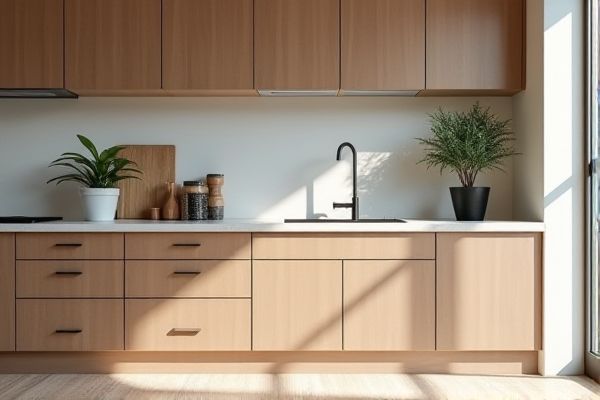
Base cabinets provide sturdy storage and countertop support at lower kitchen areas, while wall cabinets maximize vertical space by offering accessible storage above counters. Explore the rest of the article to understand how choosing between base cabinets and wall cabinets can enhance your kitchen's functionality and style.
Table of Comparison
| Feature | Base Cabinets | Wall Cabinets |
|---|---|---|
| Location | Installed on the floor | Mounted on the wall above countertop |
| Height | Typically 34.5 inches | Varies, usually 12-42 inches |
| Depth | 24 inches standard depth | 12 inches standard depth |
| Storage Type | Holds heavy items, pots, pans, appliances | Ideal for lightweight items, dishes, glassware, spices |
| Installation | Anchored to floor and wall | Secured to wall studs |
| Function | Supports countertop, provides base storage | Maximizes vertical space, easy access storage |
| Cost | Generally higher due to size and complexity | Usually lower cost per unit than base cabinets |
| Common Materials | Plywood, solid wood, MDF | Plywood, MDF, solid wood, sometimes glass fronts |
Understanding Base Cabinets: Key Features
Base cabinets serve as the foundation of kitchen storage, typically positioned beneath countertops to support work surfaces while offering ample drawer and shelf space for heavy kitchenware. Constructed with sturdy materials and designed with adjustable shelves, these cabinets provide durability and flexibility to accommodate various storage needs. Their standard height ranges from 34.5 to 36 inches, allowing ergonomic access and integration with appliances such as sinks and cooktops.
Wall Cabinets Explained: Essential Characteristics
Wall cabinets are mounted on walls, typically above countertops, providing accessible storage while saving floor space. These cabinets are shallower, usually 12 to 24 inches deep, making them ideal for storing dishes, glassware, and pantry items within easy reach. Constructed with durable materials like plywood or MDF, wall cabinets often feature adjustable shelves and various door styles to complement kitchen aesthetics and functionality.
Functional Differences Between Base and Wall Cabinets
Base cabinets provide sturdy support for countertops and house heavy kitchen appliances, offering ample storage for pots, pans, and larger kitchen tools. Wall cabinets are mounted above countertops, maximizing vertical space and ideal for storing lighter items like dishes, glassware, and spices. Understanding these functional differences can help you optimize kitchen layout for convenience and efficiency.
Space Utilization: Base vs Wall Cabinets
Base cabinets offer more storage depth and support for heavy items, making them ideal for utilizing lower kitchen space efficiently. Wall cabinets maximize vertical space without occupying floor area, perfect for storing lighter items at eye level and keeping countertops clear. Your choice between base and wall cabinets depends on balancing accessible storage needs with available kitchen layout and workflow.
Storage Capacity Comparison
Base cabinets typically offer greater storage capacity than wall cabinets due to their larger size and deeper shelves, which can accommodate heavy pots, pans, and bulkier kitchen items. Wall cabinets are designed for lighter storage, with shallower depths suited for dishes, glassware, and pantry essentials, optimizing vertical space without overwhelming the room. The overall kitchen storage efficiency depends on the strategic combination of both cabinet types, maximizing accessible space based on item size and frequency of use.
Installation Process: What to Expect
Base cabinets require floor-level alignment and precise leveling during installation to ensure stability and proper countertop fitting. Wall cabinets involve secure mounting to studs with attention to height and spacing for functionality and safety. Your choice affects installation complexity, with wall cabinets typically demanding more careful handling due to their elevated positioning.
Design and Style Options
Base cabinets offer a sturdy foundation with ample storage and countertop support, typically featuring deeper drawers and larger doors to accommodate pots, pans, and appliances. Wall cabinets are designed to maximize vertical space, often with customizable heights and glass-front options to display dishware or add decorative elements to your kitchen. Your choice between base and wall cabinets influences the overall style, allowing for sleek, contemporary designs or traditional looks tailored to your kitchen's aesthetic and functionality needs.
Cost Analysis: Base Cabinets vs Wall Cabinets
Base cabinets generally cost more than wall cabinets due to their larger size, heavier materials, and additional features like drawers and built-in supports. Installation costs for base cabinets are often higher because they require precise leveling and anchoring to the floor, whereas wall cabinets need secure mounting to wall studs but involve less groundwork. When budgeting, consider that base cabinets contribute more to overall project expenses both in materials and labor compared to wall cabinets.
Maintenance and Durability Factors
Base cabinets generally offer greater durability due to their sturdy construction and proximity to the floor, reducing exposure to moisture and heat compared to wall cabinets. You must regularly check the wall cabinets for signs of wear such as warping or loosening caused by gravity and kitchen humidity, which can impact long-term maintenance needs. Choosing high-quality materials like solid wood or plywood for both types improves longevity and reduces upkeep over time.
Choosing the Right Cabinet for Your Kitchen Needs
Base cabinets offer substantial storage space for heavy kitchen items and provide a sturdy countertop support essential for food preparation. Wall cabinets maximize vertical space, ideal for storing lighter items like dishes and glassware within easy reach. Selecting the right cabinet depends on kitchen layout, storage requirements, and accessibility preferences to optimize functionality and workflow.
 homyna.com
homyna.com